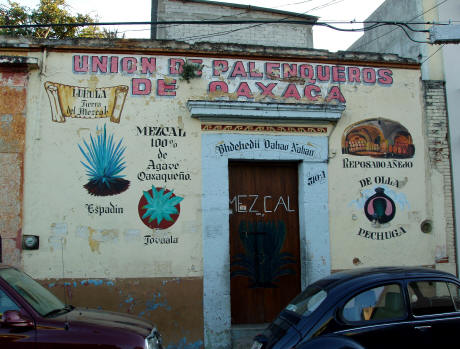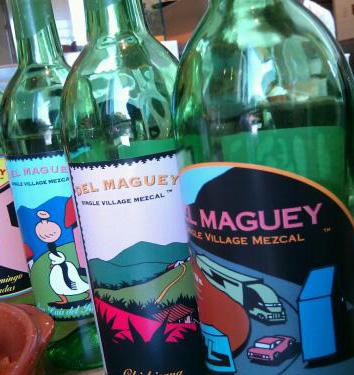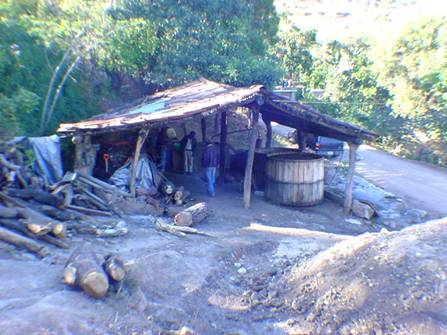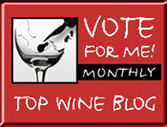 Mezcal is the national spirit of Mexico, and the one traditionally made near the town of Tequila has, over the years, become the most popular. By law, though, tequila can only be made with one species of agave, and in the past few decades tequila production has become increasingly bastardized…err, I mean mechanized. Sugars, enzymes and commercial yeasts have been tossed in, and while the resulting spirit is smoother than traditional mezcal, it’s also less expressive of the place where it’s made and of the plants that grow there—that elusive terroir. Oaxacan mezcal, on the other hand, is made from a number of different species of agave, and over the past few years true mezcal aficionados have been seeking out these handcrafted spirits, made in the pueblos of the Oaxacan hills by men using traditional methods that haven’t changed in generations. Now, these palenqueros—these artists—are getting some much-deserved attention for a craft that wasn’t always legal, and drawing a line in the sand that makes for a really interesting Angels & Demons of Mezcal.
Mezcal is the national spirit of Mexico, and the one traditionally made near the town of Tequila has, over the years, become the most popular. By law, though, tequila can only be made with one species of agave, and in the past few decades tequila production has become increasingly bastardized…err, I mean mechanized. Sugars, enzymes and commercial yeasts have been tossed in, and while the resulting spirit is smoother than traditional mezcal, it’s also less expressive of the place where it’s made and of the plants that grow there—that elusive terroir. Oaxacan mezcal, on the other hand, is made from a number of different species of agave, and over the past few years true mezcal aficionados have been seeking out these handcrafted spirits, made in the pueblos of the Oaxacan hills by men using traditional methods that haven’t changed in generations. Now, these palenqueros—these artists—are getting some much-deserved attention for a craft that wasn’t always legal, and drawing a line in the sand that makes for a really interesting Angels & Demons of Mezcal.
 For centuries, mezcal production suffered under various prohibitions and taxes, starting with an outright ban, imposed by the Spanish government. As recently as the 1970s, Mexican agents destroyed the stills of mezcal makers who hadn’t paid taxes, forcing many palenqueros underground. Today, though, the production of artisanal mezcal is becoming a legitimate enterprise, thanks in part to the efforts of an American businessman named Ron Cooper, who started Del Maguey, a company that bottles a line of mezcals and sells them in the US. Unlike Americans’ narrow view of mezcal as a spirit you pour in a shotglass—as the bottle with the worm in it—these are being crafted with passion and precision. These spirits, made from agave “hearts” which are harvested by hand with machetes, ferment naturally, in the open air. Often, the finished product, wild and unrestrained, is sold to bar owners in hand-blown bottles, each more obscure than the next.
For centuries, mezcal production suffered under various prohibitions and taxes, starting with an outright ban, imposed by the Spanish government. As recently as the 1970s, Mexican agents destroyed the stills of mezcal makers who hadn’t paid taxes, forcing many palenqueros underground. Today, though, the production of artisanal mezcal is becoming a legitimate enterprise, thanks in part to the efforts of an American businessman named Ron Cooper, who started Del Maguey, a company that bottles a line of mezcals and sells them in the US. Unlike Americans’ narrow view of mezcal as a spirit you pour in a shotglass—as the bottle with the worm in it—these are being crafted with passion and precision. These spirits, made from agave “hearts” which are harvested by hand with machetes, ferment naturally, in the open air. Often, the finished product, wild and unrestrained, is sold to bar owners in hand-blown bottles, each more obscure than the next.
 Many of these palenqueros keep a still in their garage, often with chickens roaming the property, but are slowly improving their distilleries with money from American investors that have visions of selling these artisan spirits here in the US. When Cooper first headed north across the US border in 1990, in a pickup truck piled high with bottles of mezcal, he planted the seeds of a movement. Today, a handful of other mezcal enthusiasts are prompting a sort of gold rush in the Oaxacan hills, with importers combing the countryside for the best palenqueros. Once discovered, their secrets remain closely guarded for an art form that is a far cry from the cheap frat-boy booze we once understood mezcal to be.
Many of these palenqueros keep a still in their garage, often with chickens roaming the property, but are slowly improving their distilleries with money from American investors that have visions of selling these artisan spirits here in the US. When Cooper first headed north across the US border in 1990, in a pickup truck piled high with bottles of mezcal, he planted the seeds of a movement. Today, a handful of other mezcal enthusiasts are prompting a sort of gold rush in the Oaxacan hills, with importers combing the countryside for the best palenqueros. Once discovered, their secrets remain closely guarded for an art form that is a far cry from the cheap frat-boy booze we once understood mezcal to be.
But while the palenqueros go about trying to establish themselves in an industry that previously labeled them as outlaws, way too many green, border-hopping drinkers are still being enticed (or dared) to buy mezcal by the kitsch of the worm (technically a larva) in cheap, mass-produced brands. But the expected psychedelic high always turns to toilet-hugging nausea when the bottle winds up dishing out the rough equivalent of gasoline. Memories of those experiences have kept American consumers away from the better mezcal products, even now when premium brands have started to appear on the shelves.
Yet here’s the rub…Many of the wholesale buyers who come to Oaxaca in search of the perfect mezcal say it’s not the agave that attracts foreign customers. What they want, the buyers say, is that fucking worm in their bottle. In the US, consumers see worm-spiced mezcal as a novelty item—it appeals to rugged, testosterone-amped drinkers and those who consider the worm to be an aphrodisiac. Without the worm, some producers fear mezcal will be seen as just another bottle of booze. They believe the only reason mezcal has a presence anywhere in the world is because of the worm. For these idiots, gimmick rather than quality is the way to maintain a presence in the US market. Companies like Monte Alban insist they make the best-selling mezcals in America simply because they contain a worm, not because they make an artisanal product. It’s this continual dumbing down of what could easily be Oaxaca’s “cognac” that craft palenqueros must overcome if they are going to successfully sell their life’s work here in the US.




{ 6 comments… read them below or add one }
Well said. Tequila Whisperer did a show on Mezcal back on April 5th 2010 that was very informative. He’s obnoxious but some of us love the Lipster.
And yet Tyler Florence did an episode on Mexico on this travel show of his, and his information on mezcal was shameful and misinformed….still going on about the worm crap and downing it like it was castor oil rather than looking for the “good stuff”.
Sad state of affairs!
As per the CRT (Consejo Regulador de Tequila) in Mexico, all tequila on the market that does NOT mention on the label “100% Agave” is 50% tequila and 50% other alcohol. So to make sure you are drinking tequila, check the label….and in order to be called tequila it has to be made for Blue Agave plant and distilled only in the state of Jalisco. If the distillation process occurs outside Jalisco then I believe it can be called Mezcal.
Interesting and informative Katie, as usual. I believe what Juan is referring to is what we refer to as blending. For example a blended whiskey contains some part whiskey, and some part Grain Neutral Spirit (GNS) also a form of Vodka. This in essence stretches the whiskey to fill more bottles with inferior product. Sounds like the same is true for Tequila. It would be good to know what is good tequila and what is this blended mess. I’d also love to go here to taste the Mezcal for myself. Sounds interesting.
If it doesn’t say 100% agave, count on a blended mess, like you said. Would love to go and try the mezcals myself, too. Now they’ve got a couple of quality bars focusing on artisanal mezcals here in NYC so that’s probably a shorter trip for me, though not as much fun 😉
{ 2 trackbacks }